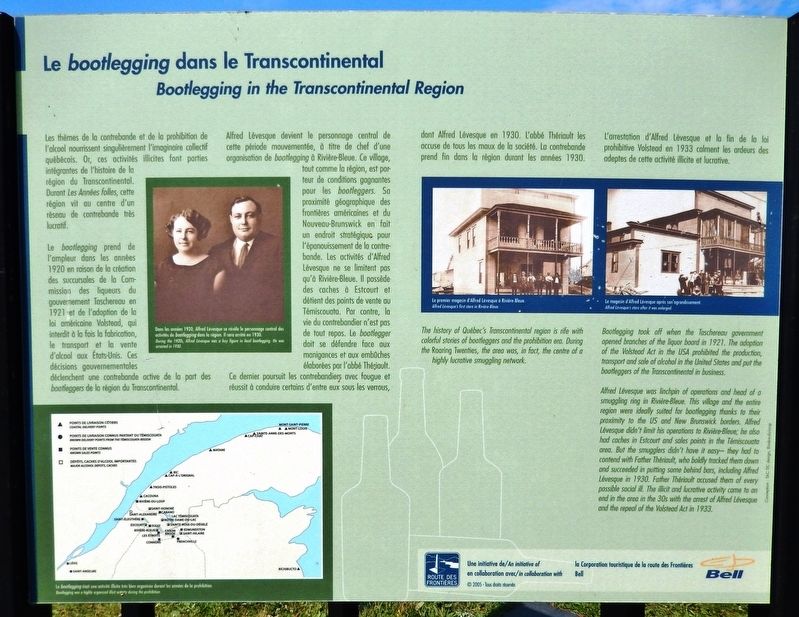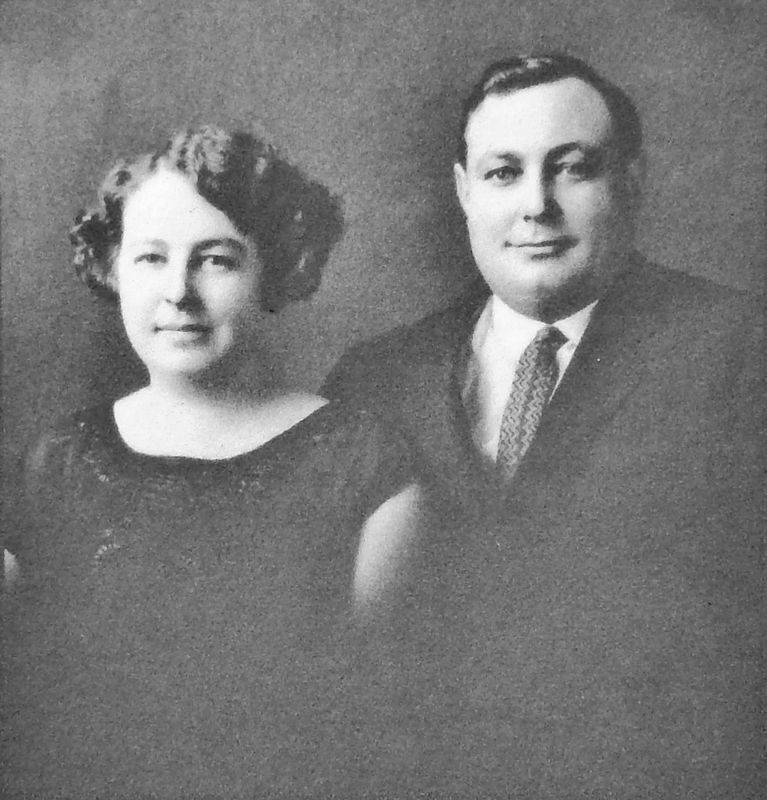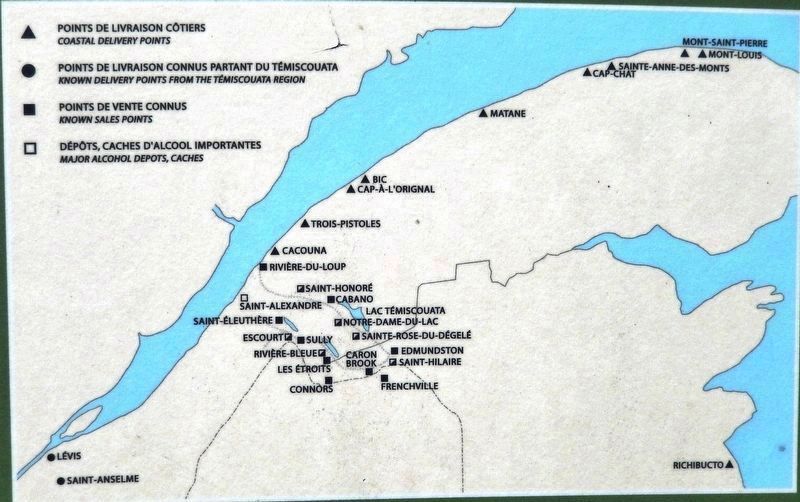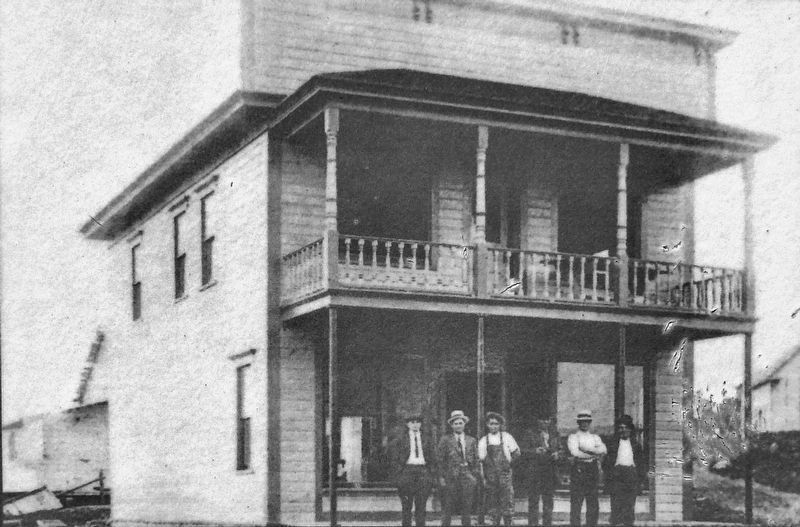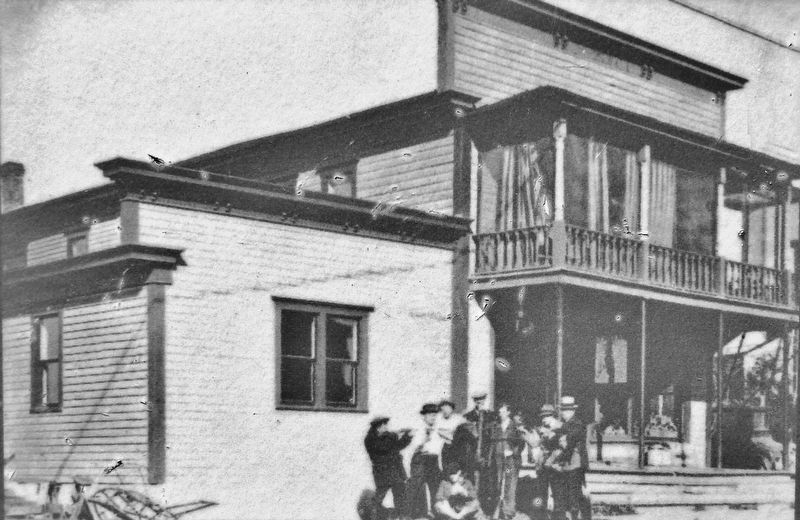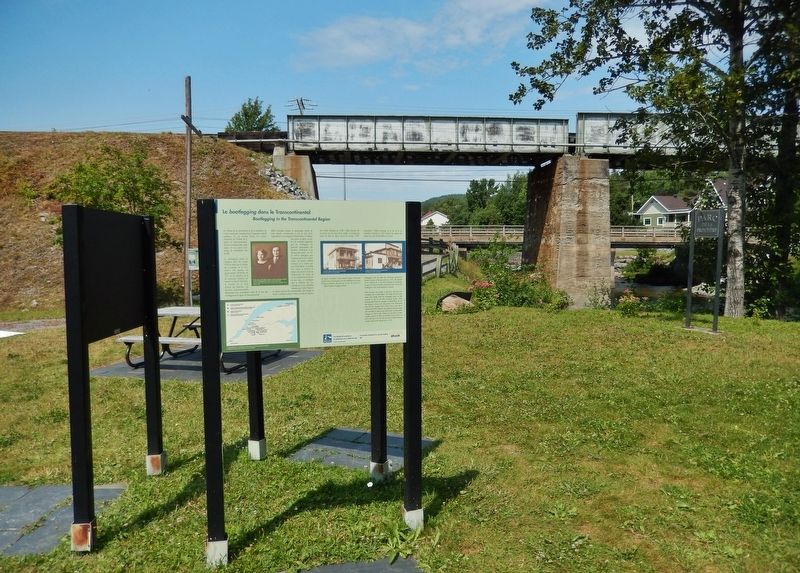Pohénégamook in Témiscouata, Québec — Central Canada (French-Canadian)
Le bootlegging dans le Transcontinental / Bootlegging in the Transcontinental Region
Inscription.
Les thèmes de la contrebande et de la prohibition de l'alcool nourrissent singulièrement l'imaginaire collectif québécois. Or, ces activités illicites font parties intégrantes de l'histoire de la région du Transcontinental. Durant Les Années folles, cette région vit ou centre d'un réseau de contrebande très lucratif.
Le bootlegging prend de l'ampleur dans les années 1920 en raison de la création des succursales de la Commission des liqueurs du gouvernement Taschereau en 1921 et de l'adoption de la loi américaine Volstead, qui interdit à la fois la fabrication, le transport et la vente d'alcool aux États-Unis. Ces décisions gouvernementales déclenchent une contrebande active de la part des bootleggers de la région du Transcontinental.
Alfred Lévesque devient le personnage central de cette période mouvementée, à titre de chef d'une organisation de bootlegging à Rivière-Bleue. Ce village, tout comme la région, est porteur de conditions gagnantes pour les bootleggers. Su proximité géographique des frontières américaines et du Nouveau-Brunswick en fait un endroit stratégique pour l'épanouissement de la contrebande. Les activités d'Alfred Lévesque ne se limitent pas qu’à Rivière-Bleue. Il possède des caches à Estcourt et détient des points de vente au Témiscouata. Par contre, la vie du contrebandier n'est pas de tout repos. Le bootlegger doit se défendre face aux manigances et aux embûches élaborées par l'abbé Thériault. Ce dernier poursuit les contrebandiers avec fougue et réussit à conduire certains d'entre eux sous les verrous, dont Alfred Lévesque en 1930. L'abbé Thériault les accuse de tous les maux de la société. La contrebande prend fin dans la région durant les années 1930. L'arrestation d'Alfred Lévesque et la fin de la loi prohibitive Volstead en 1933 calment les ardeurs des adeptes de cette activité illicite et lucrative.
The history of Québec's Transcontinental region is rife with colorful stories of bootleggers and the prohibition era. During the Roaring Twenties, the area was, in fact, the centre of a highly lucrative smuggling network.
Bootlegging took off when the Taschereau government opened branches of the liquor board in 1921. The adoption of the Volstead Act in the USA prohibited the production, transport and sale of alcohol in the United States and put the bootleggers of the Transcontinental in business.
Alfred Lévesque was linchpin of operations
and head of a smuggling ring in Rivière-Bleue. This village and the entire region were ideally suited for bootlegging thanks to their proximity to the US and New Brunswick borders. Alfred Lévesque didn't limit his operations to Rivière-Bleue; he also had caches in Estcourt and sales points in the Témiscouata area. But the smugglers didn't have it easy — they had to contend with Father Thériault, who boldly tracked them down and succeeded in putting some behind bars, including Alfred Lévesque in 1930. Father Thériault accused them of every possible social ill. The illicit and lucrative activity came to an end in the area in the 30s with the arrest of Alfred Lévesque and the repeal of the Volstead Act in 1933.
Erected by Route des Frontières, MRC de Témiscouata, and Ville de Pohénégamook.
Topics. This historical marker is listed in these topic lists: Industry & Commerce • Law Enforcement. A significant historical year for this entry is 1921.
Location. 47° 27.572′ N, 69° 13.474′ W. Marker is in Pohénégamook, Québec, in Témiscouata. Marker can be reached from Rue de la Frontière, half a kilometer north of Rue Principale (Québec Route 289) when traveling north. Marker is located in Parc de la frontière (Frontier Park). This marker is the east-facing panel of a three-panel, triangular kiosk. Touch for map
. Marker is at or near this postal address: 1161 Rue de la Frontière, Pohénégamook QC G0L 1J0, Canada. Touch for directions.
Other nearby markers. At least 5 other markers are within 14 kilometers of this marker, measured as the crow flies. La frontière canado-américaine / The Canada-USA Border (here, next to this marker); Le chemin de fer Le Transcontinental / The Transcontinental Railway (here, next to this marker); Le Pont International / The International Bridge (a few steps from this marker); Les Chemins de Fer Du Témiscouata / The Témiscouata Railways (a few steps from this marker); La gare de Rivière-Bleue / The Rivière-Bleue Train Station (approx. 13.8 kilometers away).
Related markers. Click here for a list of markers that are related to this marker. Parc de la frontière (Frontier Park)
Also see . . . Alfred Lévesque, le bootlegger. The bootlegger is Alfred Lévesque, a merchant and entrepreneur respected by his fellow citizens. From the French archipelago of Saint-Pierre-et-Miquelon, alcohol travels by boat, train, car and even hearse. He is cunning, outsmarting the police and manipulating the clergy. Loyal, he never lets his men down, even if he has to take the blame for them. A good citizen, he participates in social activities. (Submitted on November 17, 2019, by Cosmos Mariner of Cape Canaveral, Florida.)
Additional keywords.
Le bootlegging dans le Transcontinental / Bootlegging in the Transcontinental Region
Credits. This page was last revised on January 23, 2022. It was originally submitted on November 17, 2019, by Cosmos Mariner of Cape Canaveral, Florida. This page has been viewed 300 times since then and 11 times this year. Photos: 1, 2, 3, 4, 5, 6. submitted on November 17, 2019, by Cosmos Mariner of Cape Canaveral, Florida.
